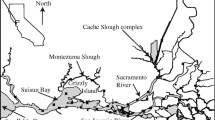Abstract
In each of six areas with various horizontal scale from 0.4 to 15.6 nautical miles, many surveys with vertical net hauls are made for sampling fish eggs and larvae. Though values ofC A are widely spread in each area, the variances 2 and the meanm of catch numbers calculated from each survey follow approximately the relation from a Poisson mixture model (PMM).
. WhereC A (Kuno's aggegation index) is generally an index of magnitude of variability in catch numbers on the surveyed space (time or time-space). Moreover, this relation is equivalent to the relation between the variance and the mean in a negative binomial distribution model (NBM). However, NBM is a special case in the PMM.
The minimum value ofC A generally depends on the horizontal scale of each area. Large values ofC A, however, are not so rare. In order to explain the large values ofC A, changes ofC A value are estimated on a simple model area that consists of two sub-areas: in one, some planktonic organisms are abundant; poor in the other. TheC A values increase with increasing area ratio of the poor sub-area to the whole area. In a widely spread area such as planktonic survey occupied, the change ofC A value mainly indicates the change of the area ratio as a result.
The Taylor's power law, a famous relation between the variance and the mean in catch numbers, has a conflict with the relation from the PMM. Within a short range of the mean, the relation is nearly a straight line on log scale. The law represented with a strictly straight line was derived mostly from data with short-ranged means, and hence the law is inadequate.
Similar content being viewed by others
References
Barnes, H. and S.M. Marshall (1951): On the variablity of replicate plankton samples and some applications of contagious series to the statistical distribution of catches over restricted periods. J. mar. biol. U.K.,30, 233–263.
Cassie, R.M. (1959): Microdistribution of plankton. N. Z. Jl. Sci.,2, 398–409.
Hewitt, R. (1981): The value of pattern in the distribution of young fish. Rapp. P.-v. Reun. Cons. int. Explor. Mer.,178, 229–236.
Iwao, S. (1968): A new regression method for analyzing the aggregation pattern of animal populations. Res. Popul. Ecol.,10, 1–20.
Iwao, S. and E. Kuno (1971): An approach to the analysis of aggregtion pattern in biological populations. p. 461–513.In: Statistical ecology, Vol. 1, Spatial patterns and statistical distributions, ed. by G.P. Patil, E.C. Pielou and W.E. Watters, Penn. State Univ. Press, University Park and London.
Iwao, S. (1977): Them*-m statistics as a comprehensive method for analyzing spatial patterns of biological populations and its application to sampling problems. p. 21–46.In: Studies of estimating population density, biomass and productivity in terrestrial animals, ed. by M. Morisita, Univ. of Tokyo Press, Tokyo.
Lloyd, M. (1967): Mean crowding. J. Anim. Ecol.,36, 1–30.
Morishita, M. (1959): Measuring of the dispersion of individuals and analysis of the distributional patterns. Mem. Fac. Sci. Kyushu Univ., Ser. E (Biol.),2, 215–235.
Silliman, R.P. (1946): A study of variability in plankton townet catches of Pacific pilchard (Sardinops caerulea) eggs. J. Mar. Res.,6, 74–83.
Taylor, L.R. (1961): Aggregation, variance and the mean. Nature, London,189, 732–735.
Taylor, L.R. and R.A.J. Taylor (1977): Aggregation, migration and population mechanics. Nature, London,265, 415–421.
Taylor, L.R., I.P. Woiwod and J.N. Perry (1978): The density dependence of spatial behaviour and the rarity of randomness. J. Anim. Ecol.,47, 383–406.
Winsor, C.P. and L.A. Walford (1936): Sampling variations in the use of plankton nets. J. Cons. perm. int. Explor. Mer,11(2), 190–204.
Zweifel, J.R. and P.E. Smith (1981): Estimates of abundance and mortality of larval anchovies (1951–75): application of a new method. Rapp. P.-v. Reun. Cons. int. Explor. Mer,178, 248–259.
Author information
Authors and Affiliations
Rights and permissions
About this article
Cite this article
Ueno, M. Relation between mean and variance in catch numbers of fish egg and larva. Journal of the Oceanographical Society of Japan 46, 125–134 (1990). https://doi.org/10.1007/BF02123439
Received:
Revised:
Accepted:
Issue Date:
DOI: https://doi.org/10.1007/BF02123439




